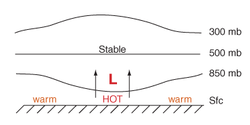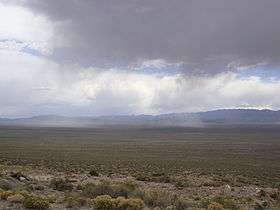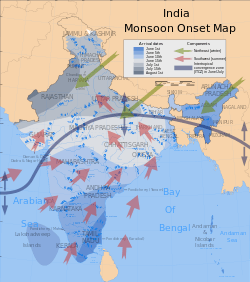Thermal low

Thermal lows, or heat lows, are non-frontal low-pressure areas that occur over the continents in the subtropics during the warm season, as the result of intense heating when compared to their surrounding environments.[1] Thermal lows occur near the Sonoran Desert, on the Mexican plateau, in California's Great Central Valley, the Sahara, over north-west Argentina in South America, over the Kimberley region of north-west Australia, the Iberian peninsula, and the Tibetan plateau.
Over land, intense, rapid solar heating of the land surface results in heating of the lowest layers of the atmosphere via reradiated energy in the infrared spectrum. The resulting hotter air is less dense than surrounding cooler air. This, combined with the rising of the hot air, results in the formation of a low pressure area. Elevated areas can enhance the strength of the thermal low as they warm more quickly than the atmosphere which surrounds them at the same altitude. Over the water, instability lows form during the winter when the air overlying the land is colder than the warmer water body. Thermal lows tend to have weak circulations, and can extend to 3,100 metres (10,200 ft) in height. Thermal lows over the western and southern portions of North America, northern Africa, and southeast Asia are strong enough to lead to summer monsoon conditions. Development of thermal lows inland of the coastline lead to the development of sea breezes. Sea breezes combined with rugged topography near the coast can encourage poor air quality.
Formation

In deserts, lack of ground and plant moisture that would normally provide evaporative cooling can lead to intense, rapid solar heating of the lower layers of air. The hot air is less dense than surrounding cooler air. This, combined with the rising of the hot air, results in a low pressure area called a thermal low.[1] Over elevated surfaces, heating of the ground exceeds the heating of the surrounding air at the same altitude above sea level, which creates an associated heat low over the terrain and enhances any thermal lows which would have otherwise existed.[2][3] During the cold season, (winter), warm water bodies such as the Great Lakes can induce an instability low.[4] Thermal lows which develop near sea level can build in height during the warm season, or summer, to the elevation of the 700 hPa pressure surface,[5] which lies near 3,100 metres (10,200 ft) above sea level.[6] Heat lows normally are stationary and have a weak cyclonic circulation.[7] As they are strongest at the surface and warm near their center, and weaker aloft where the air is more stable, the thermal low is considered warm core.[8][9] The strongest versions of these features globally are over Arabia, the northern portion of the Indian subcontinent, Arizona, Mexican plateau,[10] northwest Argentina,[11] southwestern Spain,[12] Australia,[13] and northern Africa. The formation of the heat low over northern Africa leads to a low-level westerly jet stream from June into October.[14]
Role in the monsoon regime

Monsoons are caused by the larger amplitude of the seasonal cycle of land temperature compared to that of nearby oceans. This differential warming happens because heat in the ocean is mixed vertically through a "mixed layer" that may be fifty meters deep, through the action of wind and buoyancy-generated turbulence, whereas the land surface conducts heat slowly, with the seasonal signal penetrating perhaps a meter or so. Additionally, the specific heat capacity of liquid water is significantly higher than that of most materials that make up land. Together, these factors mean that the heat capacity of the layer participating in the seasonal cycle is much larger over the oceans than over land, with the consequence that the air over the land warms faster and reaches a higher temperature than the air over the ocean. The hot air over the land tends to rise, creating an area of low pressure. This creates a steady wind blowing toward the land, bringing the moist near-surface air over the oceans with it.[15] Similar rainfall is caused by the moist ocean air being lifted upwards by mountains,[16] surface heating,[17] convergence at the surface,[18] divergence aloft, or from storm-produced outflows at the surface.[19] However the lifting occurs, the air cools due expansion in lower pressure, which in turn produces condensation.
In winter, the land cools off quickly, but the ocean keeps the heat longer due to its higher specific heat. The hot air over the ocean rises, creating a low pressure area and a breeze from land to ocean while a large area of drying high pressure is formed over the land, increased by wintertime cooling.[15] Monsoons are similar to sea and land breezes, a term usually referring to the localized, diurnal (daily) cycle of circulation near coastlines everywhere, but they are much larger in scale, stronger and seasonal.[20]
Role in sea breeze formation

The sea is warmed by the sun to a greater depth than the land due to its greater specific heat.[21] The sea therefore has a greater capacity for absorbing heat than the land, so the surface of the sea warms up more slowly than the land's surface. As the temperature of the surface of the land rises, the land heats the air above it. The warm air is less dense and so it rises. This rising air over the land lowers the sea level pressure by about 0.2%. The cooler air above the sea, now with higher sea level pressure, flows towards the land into the lower pressure, creating a cooler breeze near the coast. The strength of the sea breeze is directly proportional to the temperature difference between the land and the sea. If the environmental wind field is greater than 8 knots (15 km/h) and opposing the direction of a possible sea breeze, the sea breeze is not likely to develop.[22]
Along the California coast, the cooler water sets up a surface marine layer that is much cooler than inland areas during the summer. At the same time, the intense heating inland creates a pronounced thermal trough aligned with the Great Central Valley and typically linked to the broader thermal low across the North American deserts. As a consequence, a strong pressure gradient is created which draws cool marine air landward. As temperatures plummet, fog and stratus stream in and through the gaps of the Coast Ranges, and especially through the Golden Gate at San Francisco (see San Francisco fog). The same thermal trough is sometimes pushed toward the coast, especially in late Fall as higher pressure develops to the east due to cooling further east. This setup often brings the warmest temperatures of the year to the normally cool coastline as the seabreeze stops or is even replaced by a dangerously dry land breeze.
Role in air pollution
In areas where it is hilly or mountainous near the coastline, thermally-forced sea breezes combined with wind circulations up the sides of the mountains can encourage the production of chemicals which can lead to the development of smog. Pollution has been tracked into the mid-levels of the troposphere in the form of ozone, which is concentrated over the circulation of the thermal low as well as adjacent oceanic areas.[23]
References
- 1 2 Glossary of Meteorology (2009). Thermal Low. American Meteorological Society. Retrieved on 2009-03-02.
- ↑ National Weather Service Office in Tucson, Arizona (2008). What is a monsoon? National Weather Service Western Region Headquarters. Retrieved on 2009-03-08.
- ↑ Douglas G. Hahn and Syukuro Manabe (1975). The Role of Mountains in the South Asian Monsoon Circulation. Journal of Atmospheric Sciences, vol. 32, Issue 8, pp. 1515-1541. Retrieved on 2009-03-08.
- ↑ Nathaniel S. Winstead and Pierre D. Mourad (2000). Shallow Great Lake–Scale Atmospheric Thermal Circulation Imaged by Synthetic Aperture Radar. Monthly Weather Review: pp. 3654–3663. Retrieved on 2009-03-09.
- ↑ David R. Rowson and Stephen J. Colucci (1992). Synoptic climatology of thermal low-pressure systems over south-western north America. International Journal of Climatology, Vol. 12 Issue 6, pp. 529-545. Retrieved on 2009-03-08.
- ↑ United States Navy (2008). Forecasters Handbook for the Arctic Appendix B: Mean Monthly Sea Level Pressure, Air Temperature, and 700-mb Height. Retrieved on 2009-03-08.
- ↑ National Weather Service Forecast Office Columbia, South Carolina (2009). Weather Terms. National Weather Service Eastern Region Headquarters. Retrieved on 2009-03-08.
- ↑ Glossary of Meteorology (2009). Warm Low. American Meteorological Society. Retrieved on 2009-04-04.
- ↑ Gongyuh Lin (2008). Synoptic Weather Systems. California State University, Northridge. Retrieved on 2009-04-04.
- ↑ Donna F. Tucker (1998). The Summer Plateau Low Pressure System of Mexico. Journal of Climate: pp. 1002–1015. Retrieved on 2009-03-09.
- ↑ Marcelo E. Seluchi, A. Celeste Saulo, Matilde Nicolini, and Prakki Satyamurty (2003). The Northwestern Argentinean Low: A Study of Two Typical Events. Monthly Weather Review: pp. 2361–2378. Retrieved on 2009-03-09.
- ↑ Roger Graham Barry and Richard J. Chorley (2003). Atmosphere, Weather, and Climate. Routledge, p. 199. ISBN 978-0-415-27171-4. Retrieved on 2009-03-08.
- ↑ Bureau of Meteorology. "Climate of Giles". Retrieved 2008-05-03.
- ↑ B. Pu and K. H. Cook (2008). Dynamics of the Low-Level Westerly Jet Over West Africa. American Geophysical Union, Fall Meeting 2008, abstract #A13A-0229. Retrieved on 2009-03-08.
- 1 2 Dr. Louisa Watts (2009). What causes the west African monsoon? National Centre for Environmental Science. Retrieved on 2009-04-04.
- ↑ Dr. Michael Pidwirny (2008). CHAPTER 8: Introduction to the Hydrosphere (e). Cloud Formation Processes. Physical Geography. Retrieved on 2009-01-01.
- ↑ Bart van den Hurk and Eleanor Blyth (2008). Global maps of Local Land-Atmosphere coupling. KNMI. Retrieved on 2009-01-02.
- ↑ Robert Penrose Pearce (2002). Meteorology at the Millennium. Academic Press, p. 66. ISBN 978-0-12-548035-2. Retrieved on 2009-01-02.
- ↑ Glossary of Meteorology. Gust Front. Retrieved on 2008-07-09.
- ↑ BBC Weather. The Asian Monsoon. Retrieved on 2008-05-22.
- ↑ Dr. Steve Ackerman (1995). Sea and Land Breezes. University of Wisconsin. Retrieved on 2006-10-24.
- ↑ JetStream: An Online School For Weather (2008). The Sea Breeze. National Weather Service Southern Region. Retrieved on 2006-10-24.
- ↑ A.C. Carvalho, A. Carvalho, I. Gelpi, M. Barreiro, C. Borrego, A.I. Miranda, V. Perez-Munuzuri (2006). Influence of topography and land use on pollutants dispersion in the Atlantic coast of Iberian Peninsula. Atmospheric Environment 40 (2006) 3969–3982. Retrieved on 2009-03-09.